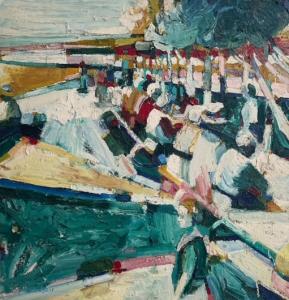
Breast cancer increases with use of electric light at night

Women who sleep with lights on get more breast cancer

Hardware stores mostly sell blue-rich LED lights
Dr Martin Moore-Ede, Author of THE LIGHT DOCTOR, provides 31 Days of Evidence that Blue-Rich White Light at Night is a Leading Cause of Breast Cancer Scientists are fully aware of the dangers of blue-rich LEDs at night, but the general public is largely unaware. Getting broader awareness would be a real achievement in Breast Cancer Awareness Month”
— Dr. Martin Moore-Ede BOSTON, MA, UNITED STATES, September 30, 2024 /EINPresswire.com/ -- Over the 31 days of October 2024, in recognition of “Breast Cancer Awareness Month”, Dr. Martin Moore-Ede, author of the new book THE LIGHT DOCTOR, will summarize the extensive evidence that the rapidly rising rates of breast cancer in young women are driven by exposure to blue-rich electric light at night.
“We know the major causes of many preventable cancers,” explains Dr. Moore-Ede, a former professor at Harvard Medical School and a leading expert on the impact of light on circadian clocks and human health. “Smoking causes most lung cancers, asbestos most mesotheliomas, human papillomavirus most cervical cancers. However, the rapid growth in breast cancer cases in young women has been regarded as a mystery until now.”
A series of 31 daily posts beginning October 1st on Instagram, Substack, and LinkedIn will explain the previously overlooked evidence, covering such topics as:
• Women who have never seen electric light rarely get breast cancer
• Breast cancer rates climbed five-fold as the world was electrified
• Breast cancer quadrupled after blue-rich fluorescent lights were introduced
• Electric light at night disrupts human circadian clocks and suppresses melatonin
• Melatonin inhibits the initiation, progression, and metastasis of breast cancer
• Higher breast cancer rates are found in those exposed to electric light on night shifts
• Blind women rarely get breast cancer
• Women who sleep with lights on at night have more breast cancer
• Light at night blocks breast cancer drugs like tamoxifen
• The World Health Organization, the American Medical Association, and the US National Institutes of Health have confirmed the carcinogenic risk of electric light.
“In the ten years since the introduction of blue-rich LED lights in 2014, another 2.6 million American women have been diagnosed with breast cancer,” notes Dr Moore-Ede. “As I explain in THE LIGHT DOCTOR, a panel of 248 of the world's leading scientific experts on circadian health and light recently urged that:
• Light used in the evening (during the three hours before bedtime) should have as little blue content as practically possible. • LED lights with high 460 - 495nm blue content should carry the warning label “may be harmful if used at night”
Unfortunately, while scientists are fully aware of the dangers of using blue-rich LEDs at night, the general public is largely unaware. Bringing this knowledge to broader public attention would be a real achievement in this October’s Breast Cancer Awareness Month,” said Dr Moore-Ede.
About Martin Moore-Ede M.D., Ph.D. For over 40 years, Dr. Moore-Ede has been a leading world expert on circadian clocks and the health problems caused by electric light at night. As a professor at Harvard Medical School (1975 – 1998), he led the team that located the suprachiasmatic nucleus, the biological clock in the human brain that controls the timing of sleep and wake. He pioneered research on how circadian clocks regulate the timing of body functions. Since 2010, he has led the Circadian Lighting Research Center team that identified the key blue signal that synchronizes circadian clocks and developed patented LED lights, which provide circadian-optimized light across day and night based on comprehensive medical research. The effectiveness of these circadian-modulated lights in improving health and well-being has been validated by installing them in the 24-hour operations of Fortune 500 companies and hospitals. He has published over 180 scientific articles and authored ten books. His latest book is THE LIGHT DOCTOR: Using Light to Boost Health, Improve Sleep and Live Longer.
Stephanie HidalgoCreative Selections LLC+1 661-617-0719[email protected] Visit us on social media:XLinkedInInstagramYouTubeOther
[embed]
Legal Disclaimer:EIN Presswire provides this news content "as is" without warranty of any kind. We do not accept any responsibility or liability for the accuracy, content, images, videos, licenses, completeness, legality, or reliability of the information contained in this article. If you have any complaints or copyright issues related to this article, kindly contact the author above.
You just read:
News Provided By
September 30, 2024, 15:08 GMT
EIN Presswire's priority is author transparency. We do our best to weed out false and misleading content. The content above is the sole responsibility of the author who makes it available. If you have any complaints, kindly contact the author above. Originally published at https://www.einpresswire.com/article/747498926/key-role-of-blue-rich-light-at-night-in-breast-cancer-is-featured-in-breast-cancer-awareness-month-education-campaign







